Vintage RCA Victor Record Players
 RCA 78 RPM Home Built Turntable with a John Vassos Tone Arm
RCA 78 RPM Home Built Turntable with a John Vassos Tone Arm
I built the 78rpm turntable described in this article for testing amplifiers used in the RCA Victor Special Models that I occasionally restore for people. I wanted to build a test platform using the same tone arm and cartridge as the RCA Special Models. Sometimes customers just send the amplifier, which is a battery operated three tube amp, using a 1G6 output tube, and it needs the higher voltage of the old crystal cartridges to properly test the amp.
I started with a turntable that appeared to be a pull from a RCA consoleI. I'm not sure of date or model, but the RCA tone arm has been around snce before WWII. I was lucky to find a John Vassos designed RCA tone arm like the ones used in the RCA Victor Special Models, with a cartridge. I sent the cartridge off to West-Tech Services for a rebuild. In the meantime I found a nice Pro-Linear AT-1600 turntable base at a very reasonable price on EBay.
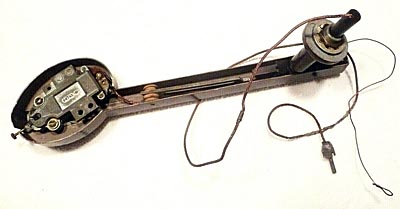 I made a new motor board from 1/2" Masonite and made cutouts for the motor mount, tone arm, and an on/off switch. The John Vassos tone arm is the same effective length from pivot to needle tip as the tone arm shown in the first image, so I mounted it in the same location on the motor board.
I made a new motor board from 1/2" Masonite and made cutouts for the motor mount, tone arm, and an on/off switch. The John Vassos tone arm is the same effective length from pivot to needle tip as the tone arm shown in the first image, so I mounted it in the same location on the motor board.
I used the original motor board as a template for the motor and tone arm cut-outs. The tracking arc is the same as the original. I also serviced the motor and installed new rubber motor grommets. The motor seems to run well, and I checked the speed with a strobe, and it is extremely accurate. I put new felt on the platter, and cleaned up the nice brass on/off toggle switch. I covered the Masonite motor board with PSA veneer. I sanded the veneer and applied two coats of Minwax Golden Oak stain and finish.
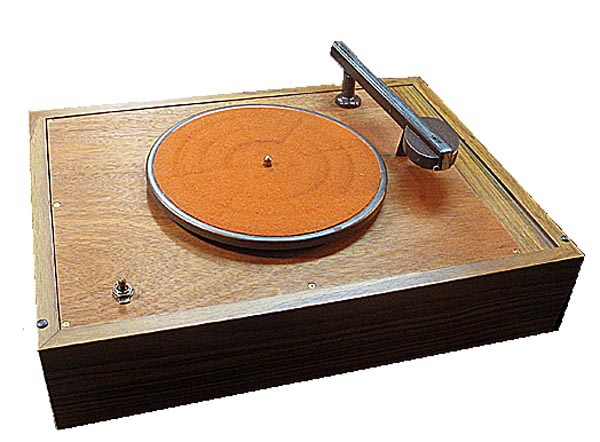
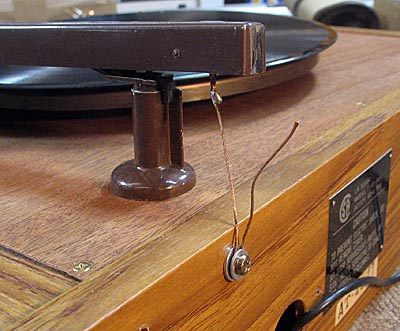 When my cartridge came back from West-Tech Services, I installed it in the tone arm and replaced the original metal shielded cable with much lighter 30 ga. wire. I mounted the tone arm perch and routed the wires down below and soldered them to an RCA phono jack I installed under the motor board. I mounted a tone arm rest I found from an old Collaro record player, then I installed the motor and on/off switch.
When my cartridge came back from West-Tech Services, I installed it in the tone arm and replaced the original metal shielded cable with much lighter 30 ga. wire. I mounted the tone arm perch and routed the wires down below and soldered them to an RCA phono jack I installed under the motor board. I mounted a tone arm rest I found from an old Collaro record player, then I installed the motor and on/off switch.
The next step was to figure out a way to adjust the tone arm pressure. The tone arm weight is 3.1 grams. The correct stylus pressure for the RCA cartridge is 2.75 ounces, so the pressure wasn't too much over, but I still wanted to get it closer to the recommended pressure. The tone arm came with a wire attached to the rear of the tone arm, which is used to raise the tone arm when it is installed in a RP-152 RCA record changer mechanism. I repurposed it to adjust tone arm pressure by using a screw and two washers at the rear of the cabinet to adjust the pressure.
Click the link for a You Tube Video of the player and a musical tour of the workshop.
You Tube Video
 1948 RCA 63E 78 RPM Record Player
1948 RCA 63E 78 RPM Record Player
The 1948 RCA Model 63E was the last self-contained 78rpm record player offered by RCA. The following year saw the introduction of the 45rpm record format. The first 45 players offered by RCA took their styling cues from the 63E. This very stylish Art Deco or Industrial Modern design is very simple with clean geometric lines. The retractable tone arm also functions as the on/off power switch, and the volume control knob is hiddden beneath the tone arm.
The machine I purchased on eBay was in very good cosmetic condition, except for the usual needle scratch across the gold colored top and some stains in the gold paint that I couldn't remove. After I removed the tone arm, motor, amplifier, tone control assembly, and switch assembly, I cleaned the cabinet with warm water and Simple Green. I used very little water and tried to avoid getting any water inside the cabinet as I did not want to damage the nice label and cardboard speaker escutcheon.
I took the cabinet to the NAPA paint store and had the gold paint color-matched. NAPA then made up an aerosol can of matching gold paint. Back home, I used 1200 and 2000 grit sandpaper to wet sand the gold portion of the cabinet to remove the needle scratch and stains. I then masked around the gold and applied a coat of primer. I wet sanded the primer and then applied two light coats of gold.
As can be seen in the photos, the results were quite good. The tones look different in the image below due to different light sources. The Nipper logo on the cabinet top is very thin foil, and trying to remove the logo risks damaging it. I covered it with masking tape and used a hobby knife to trim around the edges.

I did the usual recap of the amplifier, replacing the two electrolytic capacitors and all the paper caps. I also found quite a few resistors had drifted high, and replaced those as well. After the recap I hooked up an iPod to the amplifier input, and the audio was barely audio. After some trouble-shooting, I found that I had mistakenly installed a 5.6 Meg resistor instead of a 5.6K ohm resistor. Once I corrected that error, the amplifier played well.
The original crystal cartridge was dead, of course, so I replaced that with a Pfansteihl P-51 cartridge with 3 mil sapphire stylus. The Pfansteihl cartridge doesn't quite match up with the mounting holes for the orignal cartridge, so I had to use washers under the screw heads to make a secure installation. I replaced the tone arm wire with a lighter gauge harness to reduce weight in the tone arm.
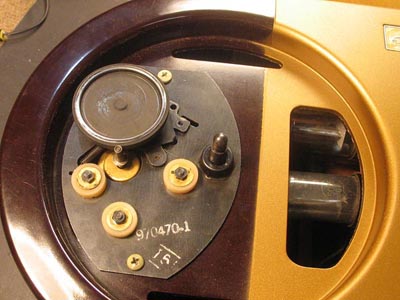
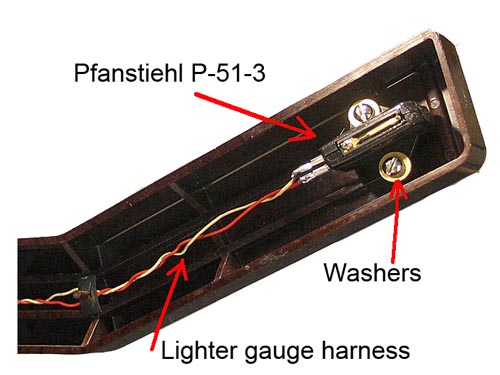 I disassembled the motor and cleaned the rotor and stator with fine sandpaper and alcohol. I applied a few drops of 3-in-One turbine oil (in the blue can) to the felt in the rotor bushings. The original motor mounts were hard and very brittle. Gary Stork at Voice of Music recommended tryng Zenith professional record changer mounts, so I ordered a set and found them to be nearly perfect replacements, except for the center hole. The original grommets had 3/16" center holes and the Zenith grommets had 1/4" center holes. I made a set of 1/4" bushings from 1/4" styrene tubing, and inserted the original 3/16" brass bushings inside the 1/4" bushings so the motor mounting bolts centered perfectly in the new mounting grommets.
I disassembled the motor and cleaned the rotor and stator with fine sandpaper and alcohol. I applied a few drops of 3-in-One turbine oil (in the blue can) to the felt in the rotor bushings. The original motor mounts were hard and very brittle. Gary Stork at Voice of Music recommended tryng Zenith professional record changer mounts, so I ordered a set and found them to be nearly perfect replacements, except for the center hole. The original grommets had 3/16" center holes and the Zenith grommets had 1/4" center holes. I made a set of 1/4" bushings from 1/4" styrene tubing, and inserted the original 3/16" brass bushings inside the 1/4" bushings so the motor mounting bolts centered perfectly in the new mounting grommets.
The rubber tire on the idler wheel had also hardened. I purchased a new #1434 idler wheel from Voice of Music. The image at left shows the installed motor with new idler wheel and motor mounting grommets. I checked the speed with a strobe disk, and the turntable speed was right at 78rpm.
 The player works very well, with good sound and perfect record speed. The tone arm mechanism sounds like a fine camera shutter as it clicks on and off. I have uploaded a video containing some restoration tips for anyone who is undertaking the restoration of one of these interesting players.
The player works very well, with good sound and perfect record speed. The tone arm mechanism sounds like a fine camera shutter as it clicks on and off. I have uploaded a video containing some restoration tips for anyone who is undertaking the restoration of one of these interesting players.
Click here for You Tube video
 1957 RCA 7-HFP-1 Hi-Fi Mono Record Player
1957 RCA 7-HFP-1 Hi-Fi Mono Record Player
In the mid-1950's RCA introduced the New Orthophonic High Fidelity series of record players. These players were available in wood consolette cabinets, and as portable versions. The 7-HFP-1 is a portable version in a very nice faux leather cabinet with a hint of European styling. Mechanically, they are very similar to the Voice of Music 900 series changers, and in fact VM was initially a supplier of changers to RCA. However, the RCA RP-xxx changers were built by RCA using some VM patents.
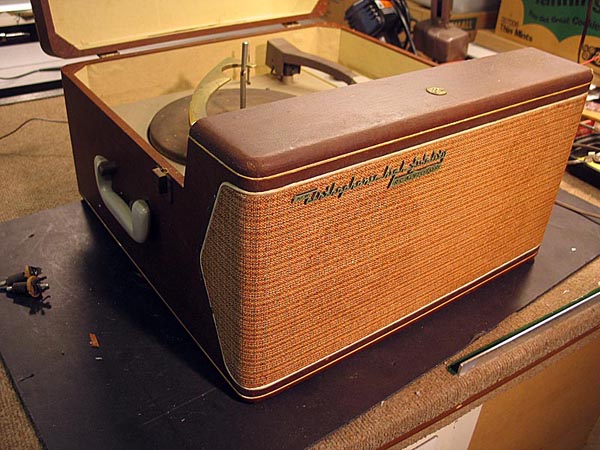 Most of the models are essentially similar, with an RP-197, RP-198, or RP-205 changer, and a three tube amplifer with a 12AX7 preamp tube and two 50C5 output tubes in a push-pull configuration. The output is fed to a three speakers, a 6.5" woofer, and two 3.5" tweeters in a crossover network via an 8uF capacitor.
Most of the models are essentially similar, with an RP-197, RP-198, or RP-205 changer, and a three tube amplifer with a 12AX7 preamp tube and two 50C5 output tubes in a push-pull configuration. The output is fed to a three speakers, a 6.5" woofer, and two 3.5" tweeters in a crossover network via an 8uF capacitor.
I purchased my 7-HFP-1 on eBay. Although the original RP-198 changer looked rough, I thought I would be able to clean it up. However, I found the the spindle was bent, and when I pulled the changer and inspected it, I found that the pickup arm lever was also bent. When someone tried to test the unit, and it wouldn't play because of dried grease, etc., they must have tried to force the mechanism, resulting in the bent pickup arm lever. While it is possible to straighten it, it may never work just right, causing cycling problems.

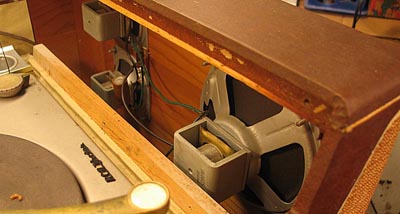
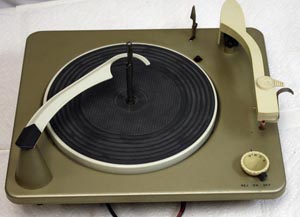
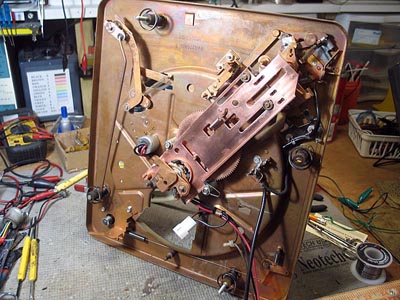 I was fortunate that a nice looking RCA RP-205 changer showed up on eBay at a fair price, and I purchased it. I disassembled the RP-205 and cleaned it, but due to wear, it also had a few issues, which were easily resolved by adjusting some of the tabs and levers on the cycling slide. I used the slide from the original RP-198 to experiment, and since it worked well, I left it in the RP-205. The RP-205 did not have a muting switch, so I moved the muting switch from the RP-198 to the RP-205. And then, I found that the counterbalance spring was missing from the RP-205 tonearm, and I had to use the spring from the RP-198 tonearm. It now cycles perfectly. I found the correct 45 adapter for the RP-205, also on eBay.
I was fortunate that a nice looking RCA RP-205 changer showed up on eBay at a fair price, and I purchased it. I disassembled the RP-205 and cleaned it, but due to wear, it also had a few issues, which were easily resolved by adjusting some of the tabs and levers on the cycling slide. I used the slide from the original RP-198 to experiment, and since it worked well, I left it in the RP-205. The RP-205 did not have a muting switch, so I moved the muting switch from the RP-198 to the RP-205. And then, I found that the counterbalance spring was missing from the RP-205 tonearm, and I had to use the spring from the RP-198 tonearm. It now cycles perfectly. I found the correct 45 adapter for the RP-205, also on eBay.
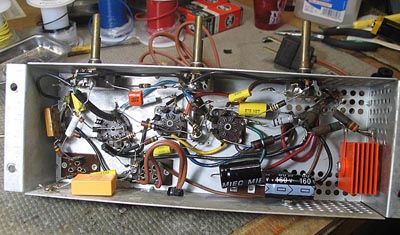
The RS-150C amplifier was recapped and several resistors that were out of tolerance replaced. The selenium rectifier was putting out the correct voltage, so I did not replace it with a silicon diode rectifier. I installed a new power cord. The 12AX7 preamp tube tested strong, so I left it alone. I found two NOS RCA 505C tubes with the same tab date on the cartons, and installed them in the amplifier.
The original cartridge that came with the changer was a Sonotone 2T, which is a good cartridge, but not stereo compliant. I had planned to install a Pfanstiehl P-228 cartridge, but the currently manufactured cartridges are only 0.5 volts, whereas the original Sonotone 2T was 1 volt or more. The weaker cartridge could affect volume and bass response.
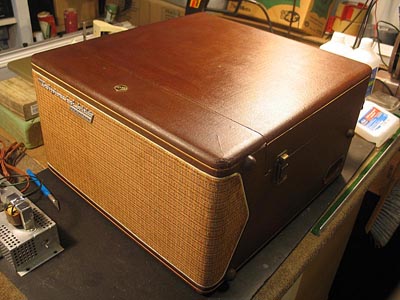 The Pfanstiehl branded P-228 is a Varco TN8U. These cartridges were originally 0.9 volt output. I searched on eBay, hoping to find a NOS earlier version with the 0.9 volt output, and found an NOS Electro-Voice 5902 cartridge, also a Varco TN8U, and hoped it would be a 0.9 volt cartridge. Based on performance, I believe that it is, as the audio output from the cartridge is strong, brilliant, and crisp, a very good match for the 7-HFP-1.
The Pfanstiehl branded P-228 is a Varco TN8U. These cartridges were originally 0.9 volt output. I searched on eBay, hoping to find a NOS earlier version with the 0.9 volt output, and found an NOS Electro-Voice 5902 cartridge, also a Varco TN8U, and hoped it would be a 0.9 volt cartridge. Based on performance, I believe that it is, as the audio output from the cartridge is strong, brilliant, and crisp, a very good match for the 7-HFP-1.
The cabinet was in pretty good shape. I cleaned the exterior with vinyl cleaner, then applied two coats of Kiwi cordovan shoe polish, then hand buffed the cabinet. I used a wire brush in a Dremel tool to clean oxidation off the brass hardware, and touched it up with brass paint, which gave it an "antiqued" look, an improvement over the "rust" look, I think. The speaker grill, I cleaned with foaming carpet cleaner. I cleaned the interior with Simple Green. I found an aerosol paint that was a close match to the interior color, and applied a light coat to the plinth, which had heavy wear and discoloration. I did the same for the trim piece that covers the speaker enclosure.
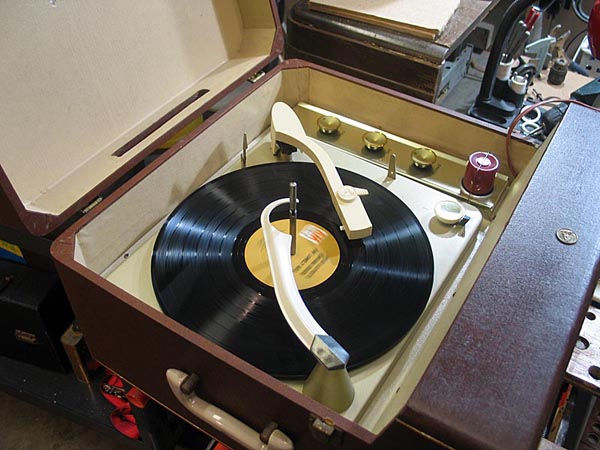
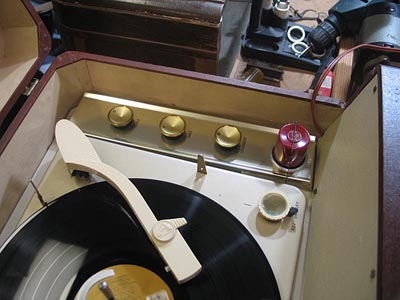
Before re-installing the restored amplifier and changer in the cabinet, I replaced the original 8uF crossover cap between the woofer and tweeters with a new Solen 8.2uF capacitor. These machines are truly very good sounding players. The EV5902 cartridge I installed seems to be an excellent match. The RS-150C amplifier and speaker combination provides very good sound for a portable record player, with good bass, clear midtones, and brilliant highs.
I also like the very way the mechanism works in these units: slow, solid, and quiet.
1951 RCA 45-EY-2 Record Player
RCA introduced the 45rpm record around 1949 to replace the 78rpm record format, and introduced a line of 45rpm only record players which have become highly collectible over the years.
For those who grew up with Rock n' Roll in the 1950's and early 1960's, these classic players bring back memories of Elvis Presley, Buddy Holly, Chuck Berry, Little Richard and other icons of the Rock n' Roll era. As found, the record player was in pretty sad shape. The base was cracked completely through just behind the volume control knob and had more than its share of battle scars. I completely disassembled the unit, taping each part to a large sheet of poster board and numbering it with the number from the parts list. I replaced all the capacitors and resistors in the amplifier, and installed a new set of tubes. This unit has the RP190-6 changer mechanism and R138F amplifier chassis.
 I sent the idler wheel and cam off to West-Tech Services in Ohio to have new rubber installed, and they returned those parts in about a week along with an Astatic 89T ceramic cartridge to replace the original crystal cartridge. While waiting for the parts from West-Tech, I repaired the crack in the base and cleaned and buffed the Bakelite. I cleaned the motorboard and polished it with automotive wax. I repainted the RCA Victor logo. The spindle, platter, and tone arm were cleaned with Novus and buffed. After installing the new cartridge and reassembling the player, it took about two hours of trial and error adjusting to get the player to cycle through the records correctly. Fortunately, there is a lot of service information on these little players available online.
I sent the idler wheel and cam off to West-Tech Services in Ohio to have new rubber installed, and they returned those parts in about a week along with an Astatic 89T ceramic cartridge to replace the original crystal cartridge. While waiting for the parts from West-Tech, I repaired the crack in the base and cleaned and buffed the Bakelite. I cleaned the motorboard and polished it with automotive wax. I repainted the RCA Victor logo. The spindle, platter, and tone arm were cleaned with Novus and buffed. After installing the new cartridge and reassembling the player, it took about two hours of trial and error adjusting to get the player to cycle through the records correctly. Fortunately, there is a lot of service information on these little players available online.
Click here to see and hear it play!
1955 RCA 7-EY-1JF Record Changer with Two Stage Amplifier
 In 1955, RCA introduced a line of 45rpm record changers targeted to teen-agers. With an attactive design and two-toned color schemes in the popular colors of the mid-fifties, these were a big hit and continue to be popular with collectors today. There were five different versions, three of which came with one stage amplifiers and two with two stage amplifiers. I found this one at a flea market for $3.00.
In 1955, RCA introduced a line of 45rpm record changers targeted to teen-agers. With an attactive design and two-toned color schemes in the popular colors of the mid-fifties, these were a big hit and continue to be popular with collectors today. There were five different versions, three of which came with one stage amplifiers and two with two stage amplifiers. I found this one at a flea market for $3.00.
It was in extremely poor condition, and cosmetically is only fair. Fortunately, these are easy players to resurrect, and a thorough cleaning, lubrication, and new idler wheel brought the mechanics back to life. Audio was another story.
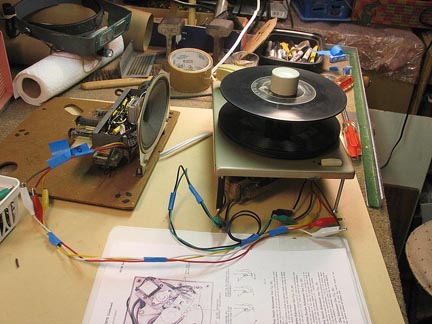 The one tube amplifier was easy enough to re-cap, but these one-tube amps were designed to work with a 3-volt crystal cartridge that is no longer available. With a one volt cartridge, audio was weak and tinny. I purchased a junker 45-EY-2 changer, like the one shown further down on this page, to transplant the amplifier into the 7-EY-1.
The one tube amplifier was easy enough to re-cap, but these one-tube amps were designed to work with a 3-volt crystal cartridge that is no longer available. With a one volt cartridge, audio was weak and tinny. I purchased a junker 45-EY-2 changer, like the one shown further down on this page, to transplant the amplifier into the 7-EY-1.
In the meantime, I was lucky enough to be offered a two stage amplifier from a 7-EY-2, which I recapped and installed. Also the 7-EY-1 used a 90 volt motor wired in series with the filaments of the orginal one stage amplifier. The two stage version requires a 110 volt motor. I swapped out the motor for the 110 volt motor from the junker 45-EY-2 and I also installed the larger speaker from the 45-EY-2 in the 7-EY-1. In the photo at right, the changer is temporarily connected to the amp while final adjustments are made to the changer cycling mechanism.
 I mounted a Pfanstiehl P188D cartridge in one half of the shell of an original crystal cartridge and installed it in the tone arm. Coupled with the two stage amplifer, audio output is robust with good tone.
I mounted a Pfanstiehl P188D cartridge in one half of the shell of an original crystal cartridge and installed it in the tone arm. Coupled with the two stage amplifer, audio output is robust with good tone.
You can hear it play in this You Tube video.
1949-1951 RCA 9JY and 45J 45 RPM Record Player Attachments
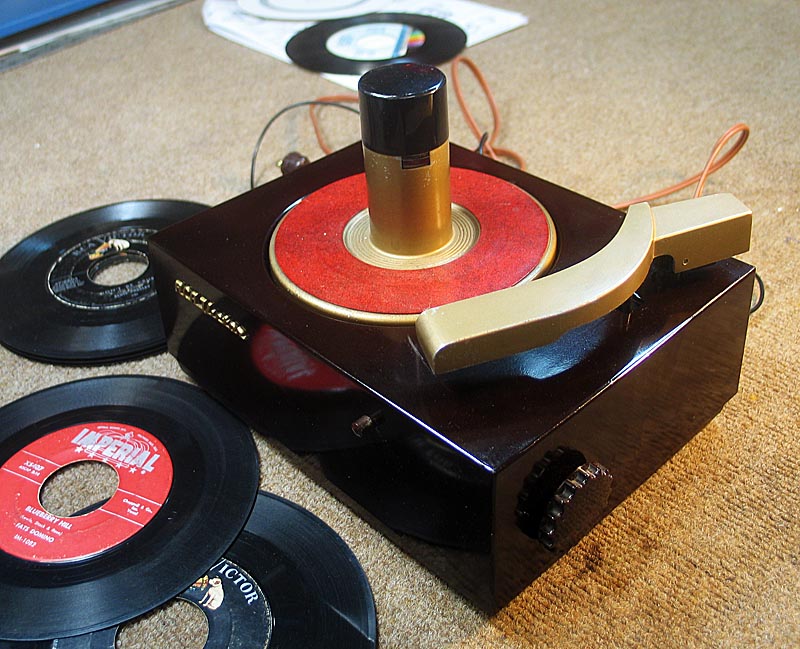 In 1949, RCA introduced the 45rpm format to replace the 78rpm record format that had been around for nearly fifty years. The new records, like the 78's, usually had one song per side. The records were made of vinyl plastic instead of shellac, and unlike 78 records, didn't break if dropped. They were, though, easily scratched, and could become warped if exposed to heat.
In 1949, RCA introduced the 45rpm format to replace the 78rpm record format that had been around for nearly fifty years. The new records, like the 78's, usually had one song per side. The records were made of vinyl plastic instead of shellac, and unlike 78 records, didn't break if dropped. They were, though, easily scratched, and could become warped if exposed to heat.
RCA had hoped that the 45 records would become the new format, but Columbia came out with the long playing 33-1/3 format at the same time, and the LP, as the format was called, become the dominant recording vinyl medium. 45 records co-existed with LP's, and teens in the 1950's up through the death of the format, kept it going as hit songs were often released as singles on the A side of the record. An interesting bit of irony, though, is that occasionally the B side would become an unintended hit, becoming more popular than the A recording.
The first 45 player was the 9JY, introduced in 1949 and designed by John Vassos. It was soon replaced with the 45J, the model shown here, with some improvements. The original 9JY was probably the faster cycling record player ever produced, and one in good condition is fascinating to watch. One of the major changes between the 9JY and 45J is in the record dropping mechanism in the spindle.
Records are stacked on the spindle, up to 8 on short spindles, or 14 on the tall spindles, and held in place by two plastic shelves. When the reject button is pushed, or the mechanism trips at the end of the record to begin a cycle, the plastic shelves pull into the spindle, allowing the bottom record to drop to the platter. At the same time, two metal knives extend outward from the spindle, just above the shelves, to hold the rest of the stack in place. Once the next record begins playing, the shelves extend back out from the spindle to support the stack, and the knives withdraw back inside the spindle untl the next cycle starts the process all over again.
The earliest 45 players used rotating knives driven by a complicated set of gears. The 45J used push-out knives in a much simpler mechanism. The cycle was still pretty fast, though, and when the last record drops, the last record will keep playing over and over again as these players did not cycle off after the last record.
The fast cycling action requires very precise adjustments when restoring these players. Restoration consists of cleaning and lubricating all the moving parts, cleaning and lubricating the electric motor, replacing motor grommets, installing a new idler wheel, and making all the necessary adjustments to enable proper cycling. Syncronizing the rotating knives on the early models could be troublesome. Adjusting the tone arm and trip lever so that as a record ends, the cycle moves the tone arm out of the way, drops a new record, and lands the tone arm at the begining of the new record is no easy task. It can take a few hours for the novice to get all these adjustments done correctly, and they must be done in the correct sequence. I won't mention how many hours I spent getting this machine to work right.
Even with all the hours I spent on adjusting the mechanism, I could never get the tripping point set to allow an extended play 45 record to play all the way through. Extended play 45's usually had finer grooves and held two songs per side. The machine does play single song 45s fine, as long as they are not abnormally long, as some are, in which case, the record will reject before the song is completed.
The first machines were called "attachments" because they had no amplifier. They were designed to be connected to a separate amplifier and speaker, and beginning in 1949, RCA began adding an RCA line-in jack in the back of many of their table top radios, so the 45 player could sit next to the radio, which served as the amplifier and speaker. Some of the models were even designed in the same brown Bakelite cabinets with matching gold accents to coordinate with the 45 players. Typically a slide switch on the rear of the radio next to the RCA line-in jack was used to toggle between PHONO and RADIO mode.
As seen in the later models shown above, RCA soon produced self-contained 45 players with built-in amps and speakers. The attachment models, however, produce much better audio when connected to a good hi-fi sound system. The early models were equipped with crystal cartridges that are no longer available. However, there are stereo-compatible ceramic cartridges that can be adapted to the tone arm in these older players, as shown above in the RCA 7-EY-1JF restoration. Cartridge kits, idler wheels, motor mount grommets, and other parts can be found for these players online. Once source is Voice of Music Enthusiasts.
Back to Record Player & Audio Menu



 I made a new motor board from 1/2" Masonite and made cutouts for the motor mount, tone arm, and an on/off switch. The John Vassos tone arm is the same effective length from pivot to needle tip as the tone arm shown in the first image, so I mounted it in the same location on the motor board.
I made a new motor board from 1/2" Masonite and made cutouts for the motor mount, tone arm, and an on/off switch. The John Vassos tone arm is the same effective length from pivot to needle tip as the tone arm shown in the first image, so I mounted it in the same location on the motor board. RCA 78 RPM Home Built Turntable with a John Vassos Tone Arm
RCA 78 RPM Home Built Turntable with a John Vassos Tone Arm
 When my cartridge came back from West-Tech Services, I installed it in the tone arm and replaced the original metal shielded cable with much lighter 30 ga. wire. I mounted the tone arm perch and routed the wires down below and soldered them to an RCA phono jack I installed under the motor board. I mounted a tone arm rest I found from an old Collaro record player, then I installed the motor and on/off switch.
When my cartridge came back from West-Tech Services, I installed it in the tone arm and replaced the original metal shielded cable with much lighter 30 ga. wire. I mounted the tone arm perch and routed the wires down below and soldered them to an RCA phono jack I installed under the motor board. I mounted a tone arm rest I found from an old Collaro record player, then I installed the motor and on/off switch. 1948 RCA 63E 78 RPM Record Player
1948 RCA 63E 78 RPM Record Player

 I disassembled the motor and cleaned the rotor and stator with fine sandpaper and alcohol. I applied a few drops of 3-in-One turbine oil (in the blue can) to the felt in the rotor bushings. The original motor mounts were hard and very brittle. Gary Stork at Voice of Music recommended tryng Zenith professional record changer mounts, so I ordered a set and found them to be nearly perfect replacements, except for the center hole. The original grommets had 3/16" center holes and the Zenith grommets had 1/4" center holes. I made a set of 1/4" bushings from 1/4" styrene tubing, and inserted the original 3/16" brass bushings inside the 1/4" bushings so the motor mounting bolts centered perfectly in the new mounting grommets.
I disassembled the motor and cleaned the rotor and stator with fine sandpaper and alcohol. I applied a few drops of 3-in-One turbine oil (in the blue can) to the felt in the rotor bushings. The original motor mounts were hard and very brittle. Gary Stork at Voice of Music recommended tryng Zenith professional record changer mounts, so I ordered a set and found them to be nearly perfect replacements, except for the center hole. The original grommets had 3/16" center holes and the Zenith grommets had 1/4" center holes. I made a set of 1/4" bushings from 1/4" styrene tubing, and inserted the original 3/16" brass bushings inside the 1/4" bushings so the motor mounting bolts centered perfectly in the new mounting grommets. The player works very well, with good sound and perfect record speed. The tone arm mechanism sounds like a fine camera shutter as it clicks on and off. I have uploaded a video containing some restoration tips for anyone who is undertaking the restoration of one of these interesting players.
The player works very well, with good sound and perfect record speed. The tone arm mechanism sounds like a fine camera shutter as it clicks on and off. I have uploaded a video containing some restoration tips for anyone who is undertaking the restoration of one of these interesting players. 1957 RCA 7-HFP-1 Hi-Fi Mono Record Player
1957 RCA 7-HFP-1 Hi-Fi Mono Record Player Most of the models are essentially similar, with an RP-197, RP-198, or RP-205 changer, and a three tube amplifer with a 12AX7 preamp tube and two 50C5 output tubes in a push-pull configuration. The output is fed to a three speakers, a 6.5" woofer, and two 3.5" tweeters in a crossover network via an 8uF capacitor.
Most of the models are essentially similar, with an RP-197, RP-198, or RP-205 changer, and a three tube amplifer with a 12AX7 preamp tube and two 50C5 output tubes in a push-pull configuration. The output is fed to a three speakers, a 6.5" woofer, and two 3.5" tweeters in a crossover network via an 8uF capacitor.


 I was fortunate that a nice looking RCA RP-205 changer showed up on eBay at a fair price, and I purchased it. I disassembled the RP-205 and cleaned it, but due to wear, it also had a few issues, which were easily resolved by adjusting some of the tabs and levers on the cycling slide. I used the slide from the original RP-198 to experiment, and since it worked well, I left it in the RP-205. The RP-205 did not have a muting switch, so I moved the muting switch from the RP-198 to the RP-205. And then, I found that the counterbalance spring was missing from the RP-205 tonearm, and I had to use the spring from the RP-198 tonearm. It now cycles perfectly. I found the correct 45 adapter for the RP-205, also on eBay.
I was fortunate that a nice looking RCA RP-205 changer showed up on eBay at a fair price, and I purchased it. I disassembled the RP-205 and cleaned it, but due to wear, it also had a few issues, which were easily resolved by adjusting some of the tabs and levers on the cycling slide. I used the slide from the original RP-198 to experiment, and since it worked well, I left it in the RP-205. The RP-205 did not have a muting switch, so I moved the muting switch from the RP-198 to the RP-205. And then, I found that the counterbalance spring was missing from the RP-205 tonearm, and I had to use the spring from the RP-198 tonearm. It now cycles perfectly. I found the correct 45 adapter for the RP-205, also on eBay.
 The Pfanstiehl branded P-228 is a Varco TN8U. These cartridges were originally 0.9 volt output. I searched on eBay, hoping to find a NOS earlier version with the 0.9 volt output, and found an NOS Electro-Voice 5902 cartridge, also a Varco TN8U, and hoped it would be a 0.9 volt cartridge. Based on performance, I believe that it is, as the audio output from the cartridge is strong, brilliant, and crisp, a very good match for the 7-HFP-1.
The Pfanstiehl branded P-228 is a Varco TN8U. These cartridges were originally 0.9 volt output. I searched on eBay, hoping to find a NOS earlier version with the 0.9 volt output, and found an NOS Electro-Voice 5902 cartridge, also a Varco TN8U, and hoped it would be a 0.9 volt cartridge. Based on performance, I believe that it is, as the audio output from the cartridge is strong, brilliant, and crisp, a very good match for the 7-HFP-1.

 I sent the idler wheel and cam off to West-Tech Services in Ohio to have new rubber installed, and they returned those parts in about a week along with an Astatic 89T ceramic cartridge to replace the original crystal cartridge. While waiting for the parts from West-Tech, I repaired the crack in the base and cleaned and buffed the Bakelite. I cleaned the motorboard and polished it with automotive wax. I repainted the RCA Victor logo. The spindle, platter, and tone arm were cleaned with Novus and buffed. After installing the new cartridge and reassembling the player, it took about two hours of trial and error adjusting to get the player to cycle through the records correctly. Fortunately, there is a lot of service information on these little players available online.
I sent the idler wheel and cam off to West-Tech Services in Ohio to have new rubber installed, and they returned those parts in about a week along with an Astatic 89T ceramic cartridge to replace the original crystal cartridge. While waiting for the parts from West-Tech, I repaired the crack in the base and cleaned and buffed the Bakelite. I cleaned the motorboard and polished it with automotive wax. I repainted the RCA Victor logo. The spindle, platter, and tone arm were cleaned with Novus and buffed. After installing the new cartridge and reassembling the player, it took about two hours of trial and error adjusting to get the player to cycle through the records correctly. Fortunately, there is a lot of service information on these little players available online. In 1955, RCA introduced a line of 45rpm record changers targeted to teen-agers. With an attactive design and two-toned color schemes in the popular colors of the mid-fifties, these were a big hit and continue to be popular with collectors today. There were five different versions, three of which came with one stage amplifiers and two with two stage amplifiers. I found this one at a flea market for $3.00.
In 1955, RCA introduced a line of 45rpm record changers targeted to teen-agers. With an attactive design and two-toned color schemes in the popular colors of the mid-fifties, these were a big hit and continue to be popular with collectors today. There were five different versions, three of which came with one stage amplifiers and two with two stage amplifiers. I found this one at a flea market for $3.00. The one tube amplifier was easy enough to re-cap, but these one-tube amps were designed to work with a 3-volt crystal cartridge that is no longer available. With a one volt cartridge, audio was weak and tinny. I purchased a junker 45-EY-2 changer, like the one shown further down on this page, to transplant the amplifier into the 7-EY-1.
The one tube amplifier was easy enough to re-cap, but these one-tube amps were designed to work with a 3-volt crystal cartridge that is no longer available. With a one volt cartridge, audio was weak and tinny. I purchased a junker 45-EY-2 changer, like the one shown further down on this page, to transplant the amplifier into the 7-EY-1. I mounted a Pfanstiehl P188D cartridge in one half of the shell of an original crystal cartridge and installed it in the tone arm. Coupled with the two stage amplifer, audio output is robust with good tone.
I mounted a Pfanstiehl P188D cartridge in one half of the shell of an original crystal cartridge and installed it in the tone arm. Coupled with the two stage amplifer, audio output is robust with good tone. In 1949, RCA introduced the 45rpm format to replace the 78rpm record format that had been around for nearly fifty years. The new records, like the 78's, usually had one song per side. The records were made of vinyl plastic instead of shellac, and unlike 78 records, didn't break if dropped. They were, though, easily scratched, and could become warped if exposed to heat.
In 1949, RCA introduced the 45rpm format to replace the 78rpm record format that had been around for nearly fifty years. The new records, like the 78's, usually had one song per side. The records were made of vinyl plastic instead of shellac, and unlike 78 records, didn't break if dropped. They were, though, easily scratched, and could become warped if exposed to heat.